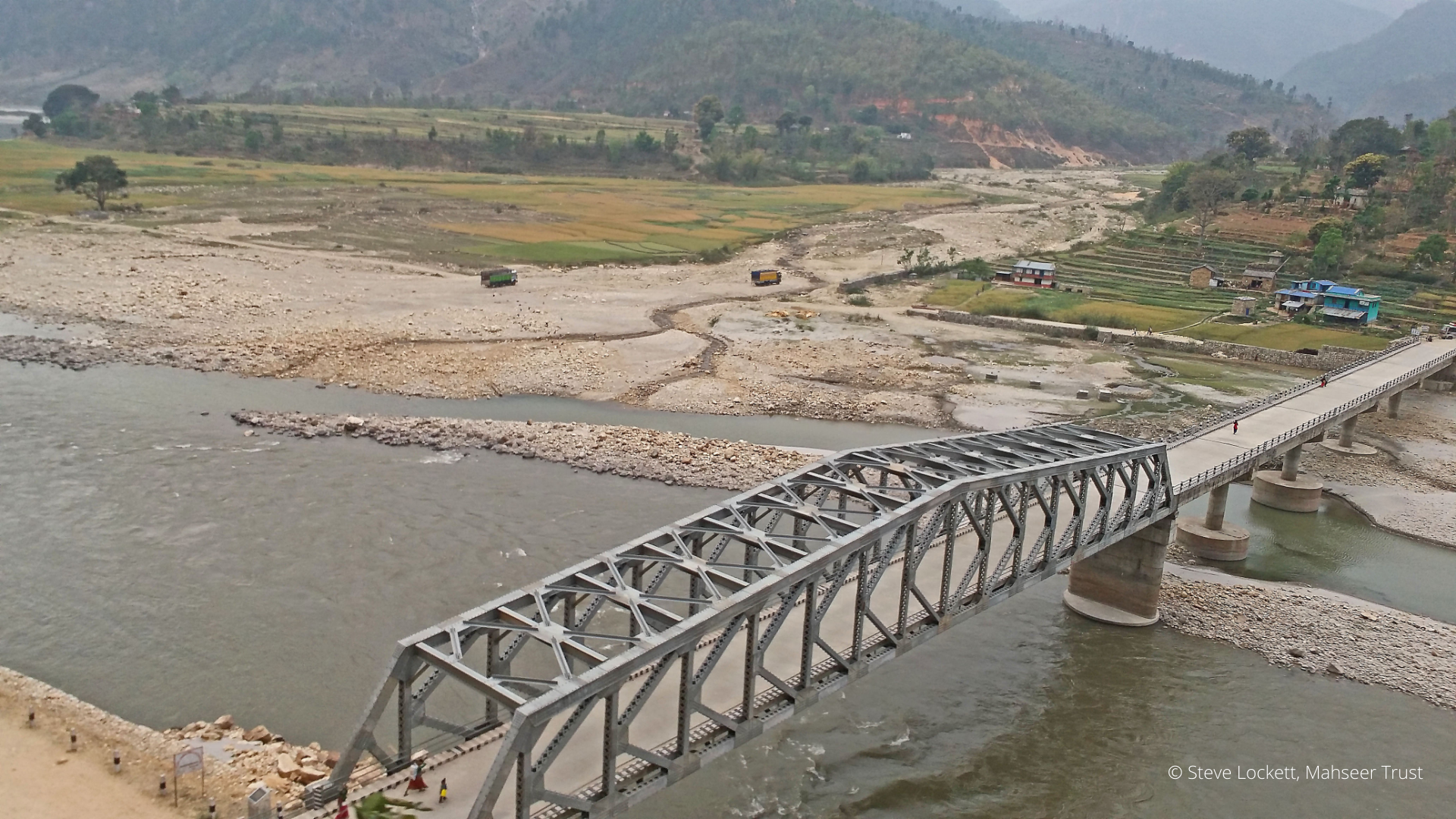Sand from sacred sources: Guest post by Steve Lockett - Mahseer Trust
It was too good to miss. An invitation to speak on behalf of freshwater biodiversity also offered the chance for me to see the sacred Karnali River; the only major river to cross Nepal un-dammed and free-flowing. The event was Nepal River Conservation Trust’s (NRCT) 3rd National River Summit, with support from Paani, a holistic river conservation and development organisation funded by US-AID.
Following a stunning, two-hour flight, parallel to the high Himalayas, from Kathmandu to Surkhet, all delegates then had an eight-hour coach transfer to the remote village of Rakam. We arrived late in the night, but the first morning of the summit, emerging from my tent, gave me a glimpse of the wonder of the river landscape. Glints of silver among the glaring white sand beaches along the river gave way to steep hills that framed the scene on either side.
Sand and gravel mining were barely mentioned during the conference, and it leaves me wondering if we have done Nepal’s rivers and the local people who have to face the devastating consequences of loss of substrate, a huge disservice.
Powerful landscape
The river here feels very alive and dynamic. Huge sand and gravel beds pay testament to the erosive power of this mountain-chewing force of nature. Yet still, people live hand-in-hand with the flow as they have done for centuries, aware of the power to give and the power to take away. The yearly cycle of flood and retreat offers up a threat to property and lives, but also brings the nourishing sediment to the fields, and water to irrigate crops.
From my perspective, as a delegate for the role of fish within overall river biodiversity, the extensive gravel beds showed clearly how good the habitat is for spawning. Locals eat snow trout as a major part of their protein intake, and the larger, migratory mahseer that are my special interest offer a bigger meal and the opportunity to earn tourist income from angling. Any threat to the sediment regime is a threat to these livelihood requirements.
Development was high on the conference agenda, with ongoing plans for three large dams a hot topic of debate. Those speaking in favour of the dams were keen to impress with the benefits their projects could bring to the seemingly impoverished locals: electricity; water; schools; hospitals and roads. The locals who spoke about their development wishes only mentioned water, they have ample solar power for lighting, cooking is by gas. There is no doubt that sediment transportation will be lost if the dams do come up and the migration routes of fish will be blocked.
Around the village, and all along the road into the valley, there is evidence of sand mining. Excavators are at work, or stand ready; trucks battle against buses on the narrow and crumbling hillside roads. For now, much of the sand and gravel removal is small scale, to allow repairs to local houses and to build bridges where tight bends offer precarious travel, or where streams cascade to the main stem of the river, undercutting the existing road.
Traditionally, there are only two other ways in and out of these mid-altitude valleys: walking along mountain tracks, or rafting down the river. A better road system is always in the minds of those helping with development works. US-AID have prepared reports on some stretches of the river basin, these always giving reference to the need for roads. Thuligad (see final link, below), for instance, is a major tributary, with extensive deposition, thriving fishing, and a strong agriculture sector, but while there has been development of transport links, the report says “poor and marginalised communities have been neglected in terms of access.”
Lie of the Land
A journey through the whole river catchment in 2018 for the Karnali River Expedition allowed retired geomorphologist, Karen Bennett, to make a first-hand assessment of the fragility of the terrain, and the unique challenges faced by those planning infrastructure development.
“There is a desperate need for better connectivity but it has to be done with the safety of the locals in mind.” She said. “Roads need to be viable for 12 months of the year. Most of the existing access roads close during the monsoon because of landslides. Nepal has road construction standards, but nobody is enforcing them. Even on state designed and mandated roads, nobody follows the planning and design norms, it is simply ‘recreational bulldozing’!
“Many individuals, who can afford it, have roads built directly to their houses. Mostly, these collapse in very quick time, either triggered by, or causing localised landslides and contributing to a massive, fast change in the natural sedimentation, erosion and deposition process.”
This whole area is still extremely seismically active, with geological forces supplying nutrients to the river itself as well as human habitation. The flip side is that development is constantly threatened by the risk of a major earthquake. Although, in the past, roads that have been built according to the design plans have withstood the shocks and emerged from big events intact, and still able to offer relief to locals in need.
It seems very obvious to me that, given the power of the sand mafias in other parts of the Indian sub-continent, better connectivity would also give these illegal operators access to structurally important sediments. In a previous article, I demonstrated the ways in which these people work, and the threats they pose to ordinary villagers trying to live their lives alongside rivers.
My friend, top Indian environmental lawyer, Shiyafiq Siddiqui, has said that the sand mafia is probably the most ruthless illegal operation in the world. We must ask if better connectivity will also leave the villagers at their mercy? And if the river’s vital sand will be stolen along with Rakam’s dreams?
References
https://www.dai.com/our-work/projects/Nepal-Program-for-Aquatic-Natural-Resources-Improvement-PANI
http://www.hakahakionline.com/np/wp-content/uploads/2018/07/Thuligaad-watershed-health-report-March_2-2018_FINAL-DRAFT-AT.pdf
Disclaimer: The views expressed are those of the author/s and they do not necessarily reflect the views of SandStories







